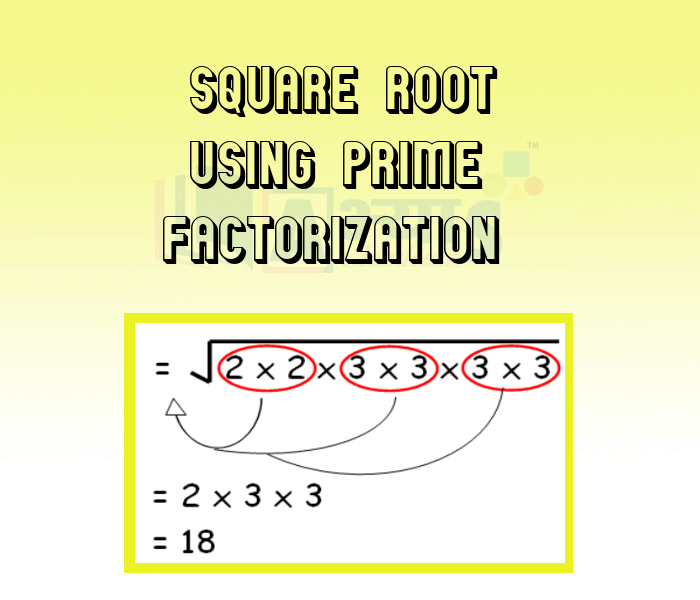Square Root Using Prime Factorization





Square Root Using Prime Factorization
Square Root: The square root of a number a is that number which when multiplied by itself gives 'a' as the product.
Property: Negative numbers have no square root in the system of rational numbers.
Explanation:
We have, and so on.
Also,
and so on. This means that the square of a number whether positive or negative is always positive. Consequently, negative numbers are not perfect squares. Hence, negative have no square roots.
Square Root Of a Perfect Square By Prime Factorization
In order to find the square root of a perfect square by prime factorization, we follow the following steps.
STEP I Obtain the given number.
STEP II Resolve the given number into prime factors by successive division.
STEP III Make pairs of prime factors such that both the factors in each pair are equal. Since the number is a perfect square, you will be able to make an exact number of pairs of prime factors.
STEP IV Take one factor from each pair.
STEP V Find the product of factors obtained in step IV.
STEP VI The product obtained in step V is the required square root.
The following examples will illustrate the above procedure.
Illustration 1: Find the square root of 7744 by prime factorization.
By which smallest number 48 must be divided so as to make it a perfect square ? | |||
| Right Option : B | |||
| View Explanation | |||
Class'X-A' of a school collected Rs.1024 As contribution to AP Flood Refief Fund . If each student contributed as one student in the class . The number of students in the class are _______________ | |||
| Right Option : B | |||
| View Explanation | |||
By what numbers should each of the following be divided to get a perfect square each case? Also, find the number whose square is the new number : 1575 | |||
| Right Option : C | |||
| View Explanation | |||
Students / Parents Reviews [10]
About Abhyas metholodology the teachers are very nice and hardworking toward students.The Centre Head Mrs Anu Sethi is also a brilliant teacher.Abhyas has taught me how to overcome problems and has always taken my doubts and suppoeted me.

Shreya Shrivastava
8thMy experience with Abhyas academy is very good. I did not think that my every subject coming here will be so strong. The main thing is that the online tests had made me learn here more things.

Hiya Gupta
8thI have spent a wonderful time in Abhyas academy. It has made my reasoning more apt, English more stronger and Maths an interesting subject for me. It has given me a habbit of self studying

Yatharthi Sharma
10thMy experience with Abhyas is very good. I have learnt many things here like vedic maths and reasoning also. Teachers here first take our doubts and then there are assignments to verify our weak points.

Shivam Rana
7thBeing a parent, I saw my daughter improvement in her studies by seeing a good result in all day to day compititive exam TMO, NSO, IEO etc and as well as studies. I have got a fruitful result from my daughter.

Prisha Gupta
8thAbhyas is a complete education Institute. Here extreme care is taken by teacher with the help of regular exam. Extra classes also conducted by the institute, if the student is weak.

Om Umang
10thAbhyas Methodology is very good. It is based on according to student and each child manages accordingly to its properly. Methodology has improved the abilities of students to shine them in future.

Manish Kumar
10thIt has a great methodology. Students here can get analysis to their test quickly.We can learn easily through PPTs and the testing methods are good. We know that where we have to practice

Barkha Arora
10thA marvelous experience with Abhyas. I am glad to share that my ward has achieved more than enough at the Ambala ABHYAS centre. Years have passed on and more and more he has gained. May the centre flourish and develop day by day by the grace of God.

Archit Segal
7thIt was good as the experience because as we had come here we had been improved in a such envirnment created here.Extra is taught which is beneficial for future.
